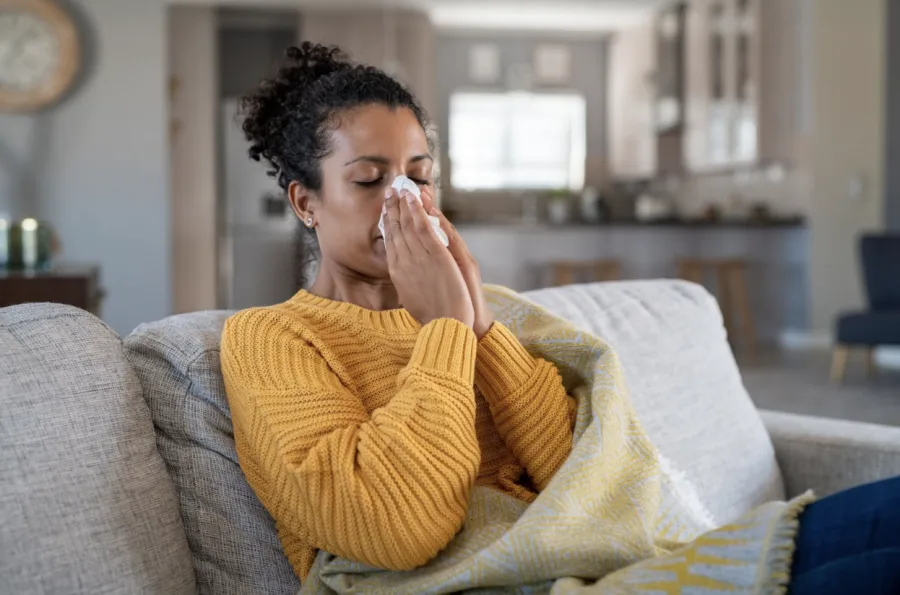
The reason behind the flu season: How much do you know?
Hey Canada, remember the flu? Yup, it's that time of year again. As we enter the cool and crisp fall-winter months, the inevitable flu season knocks on our door.
As Canadians we hear about it annually — but how much do we really know about the seasonal flu, and better yet, how well do we prepare for it?
To better understand the reason behind the flu season, let's first look at how the virus behaves.
“The flu is a contagious respiratory airborne virus that’s typically spread through droplets," explained Rexall Senior Manager of Virtual and Pharmacy Services, Amit Joshi. "When an infected individual coughs or sneezes, those in close proximity may catch the flu.”
Typically in Canada, the flu season strikes in the fall and winter months and weather is a very big reason for it. From November to March, the air tends to be drier and less humid, making conditions easier for the virus to spread.
RELATED: Cough and cold season has arrived… are you ready?
Pair this with an increase in indoor gatherings and face-to-face contact with our loved ones, and your chances of catching the flu from an infected person just went up.
“We tend to move indoors during the holidays and we are in very close proximity with our friends and family. For any respiratory illness that makes it easier for it to spread,” added Joshi.
According to the Centers for Disease Control and Prevention (CDC), flu symptoms usually come on suddenly and last anywhere between 3-7 days.
People who have flu often feel some or all of these symptoms:
fever* or feeling feverish/chills
cough
sore throat
runny or stuffy nose
muscle or body aches
headaches
fatigue (tiredness)
some people may have vomiting and diarrhea, though this is more common in children than adults
*It’s important to note that not everyone with the flu will have a fever.

Flu cases tend to rise during fall and winter months as people congregate indoors. (Getty Images/stock photo)
While winter can be the season for celebrations, it wasn’t always this way. Rewind to the height of COVID-19 when people were asked to limit their interactions with others or isolate all together especially during the holidays.
In fact, with COVID-19 taking center stage, the influenza vaccine took somewhat of a backseat.
“When we look at what's happened the last two years, we've been under COVID lockdown measures. We've been keeping physical distance and wearing masks," explained Joshi. "Not only did that stop the spread of COVID-19 but it also stopped a lot of other viral illnesses like the flu. So there hasn't really been the flu season for the last two years. And a lot of that natural immunity in our communities, and in healthier individuals has started to drop off… so the only immunity really would be from vaccinations at this point.”
The vulnerable populations most at risk from serious illness from influenza are:
People with medical conditions
Children under 5-years-old
Seniors 65-years-plus
People with autoimmune disease

For those that are eligible, health experts say it's perfectly safe to get your flu shot and your COVID booster at the same time. (Getty Images/stock photo)
According to the CDC, during seasons when flu vaccine viruses are similar to circulating flu viruses, flu vaccines have been shown to reduce the risk of having to go to the doctor with flu by 40 to 60 per cent.
DON'T MISS: Can your joints predict when a storm is coming?
To help reduce the risk of infection remember to:
Wash your hands regularly
Eat fruits and vegetables
Use a humidifier
Get vaccinated if eligible
Stay home when sick to avoid infecting others
But why do we have to get the flu vaccine year after year?
“Every year, studies are done in other parts of the world to see what virus strains are going to be in circulation this year and then the vaccine is created to be able to match what's in circulation,” explained Joshi.
“So not only does your immune protection start to wear overtime but also your ability to get updated vaccines that better match the strains that are in circulation… It's perfectly safe to get your flu shot and your COVID vaccine at the same time if eligible,” Joshi continued.
The most common symptoms a person can experience after being administered the flu shot are: soreness, redness and swelling in the location the shot was given. These symptoms can last for 1-2 days after getting your shot.
With these health tips, we hope you can shut the door on the seasonal flu and get the most out of the season of celebrations with your loved ones.











